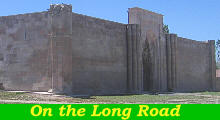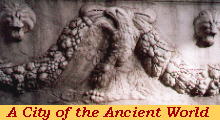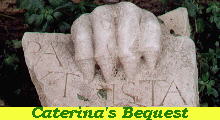  What's New! Detailed Sitemap All images © by Roberto Piperno, owner of the domain. Write to romapip@quipo.it. Text edited by Rosamie Moore. Page added in August 2008. |
  - Kayseri - page one - Kayseri - page one(Sultanhan) The name of the town is a reference to Julius Caesar. In the early Ist century AD the town of Mazaca/Eusebia was renamed Caesarea (in Latin), Kaysareia (in Greek). This occurred when the small kingdom of Cappadocia was made a Roman province.
Kayseri is located at the northern foot of Mount Argaeus (today Erciyes), the highest mountain of Central Anatolia. According to the ancient geographer Strabo the view from its peak ranged from the Mediterranean Sea to the Black Sea; this is not true, but Mount Argaeus is a very imposing mountain which can be seen from a very great distance. Yeni Camii, the large mosque shown in the photo, is a very recent building (Yeni = new) and it is an indication of both the wealth of today's Kayseri and of the strong religious feelings of its inhabitants. In addition Yeni Camii shows the reluctance of modern Turkish architects to depart from traditional Ottoman patterns.
Kayseri was one of the first important Byzantine towns to be conquered by Turkish tribes. This occurred in 1084. Later on it was included in the Sultanate of Rum. Its fortifications were strengthened by Sultan Alaeddin Keykubad I in 1224. However this was not enough to avoid Kayseri falling to the Mongols in 1243.
Sultan Alaeddin Keykubad I placed two roughly cut stone lions at the sides of the main entrance to the citadel. The town was also protected by an enclosure of walls of which a few stretches survive. They were recently restored (maybe a bit too much).
The Great Mosque of Kayseri was built in 1134-1143 when Kayseri was part of an emirate established by the Danishmend, a Turcoman dynasty which ruled parts of eastern (and central) Anatolia. The mosque is large, but rather low while its minaret is very tall. What attracts the attention is the long portico where the faithful do their ablutions before entering the mosque.
It was built in 1247 for Melik Adile Hatun, wife of Sultan Alaeddin Keykubad I. Kayseri is an important centre for the funerary architecture of the Seljuk period and of the two following centuries during which the city was often the capital of autonomous principalities. It houses a considerable number of kumbets (turbe - tombs - with a domed/pyramidal roof) some of which were built for a Hatun, the wife of a sultan or a governor. They seem to have been more decorated as compared to the kumbets constructed for men.
Usually kumbets were built next to a mosque or inside a medrese, but in Kayseri there are many isolated kumbets in different parts of the city, occasionally at a significant distance from its centre.
This circular (doner) kumbet was built in 1275 for Sah Cihan Hatun, a princess. It has twelve sides: each is finely carved. In addition to floral and geometric motifs some panels contain palms and animal figures. Also the conical roof has a light decoration based on twelve blind arches. Move to page two.     |






